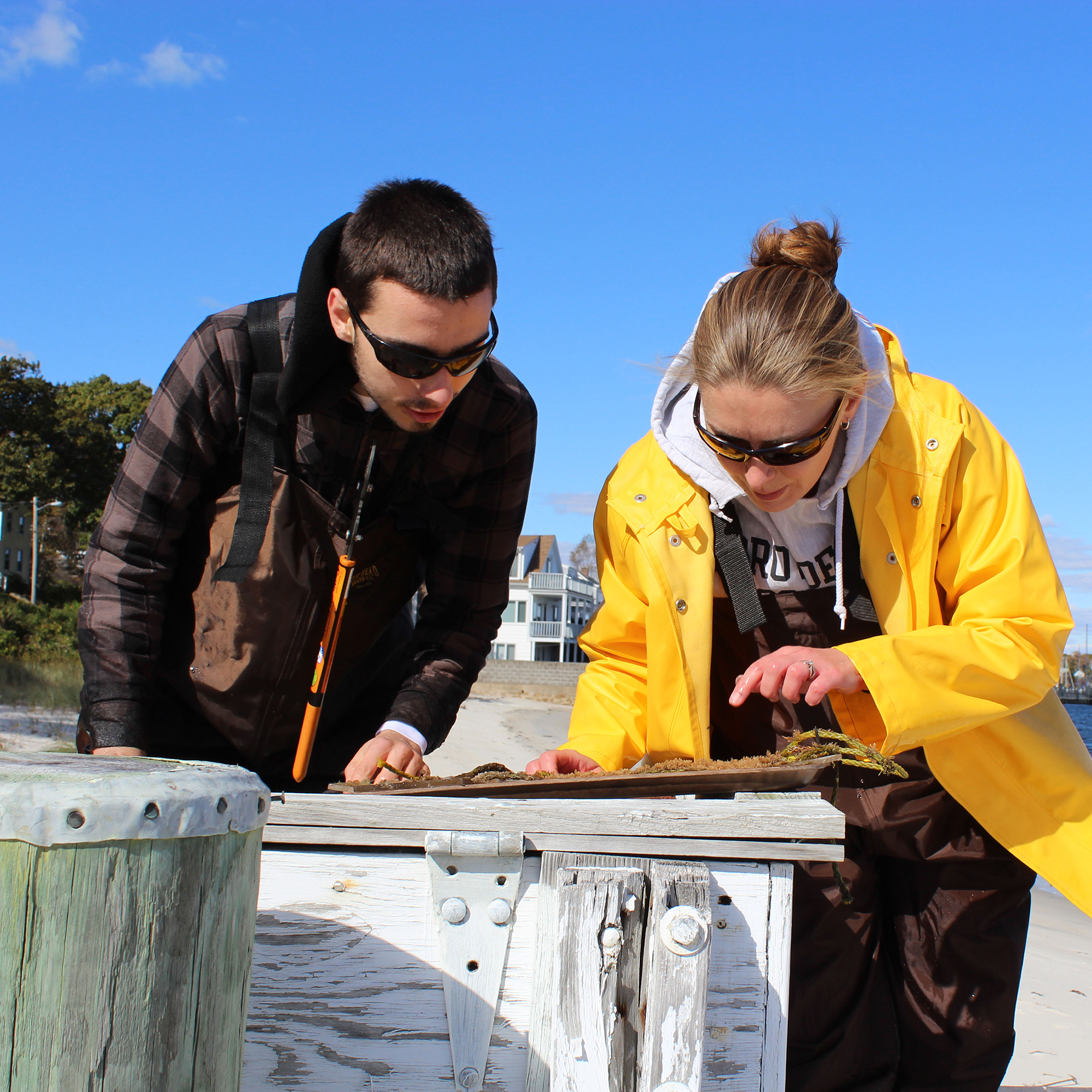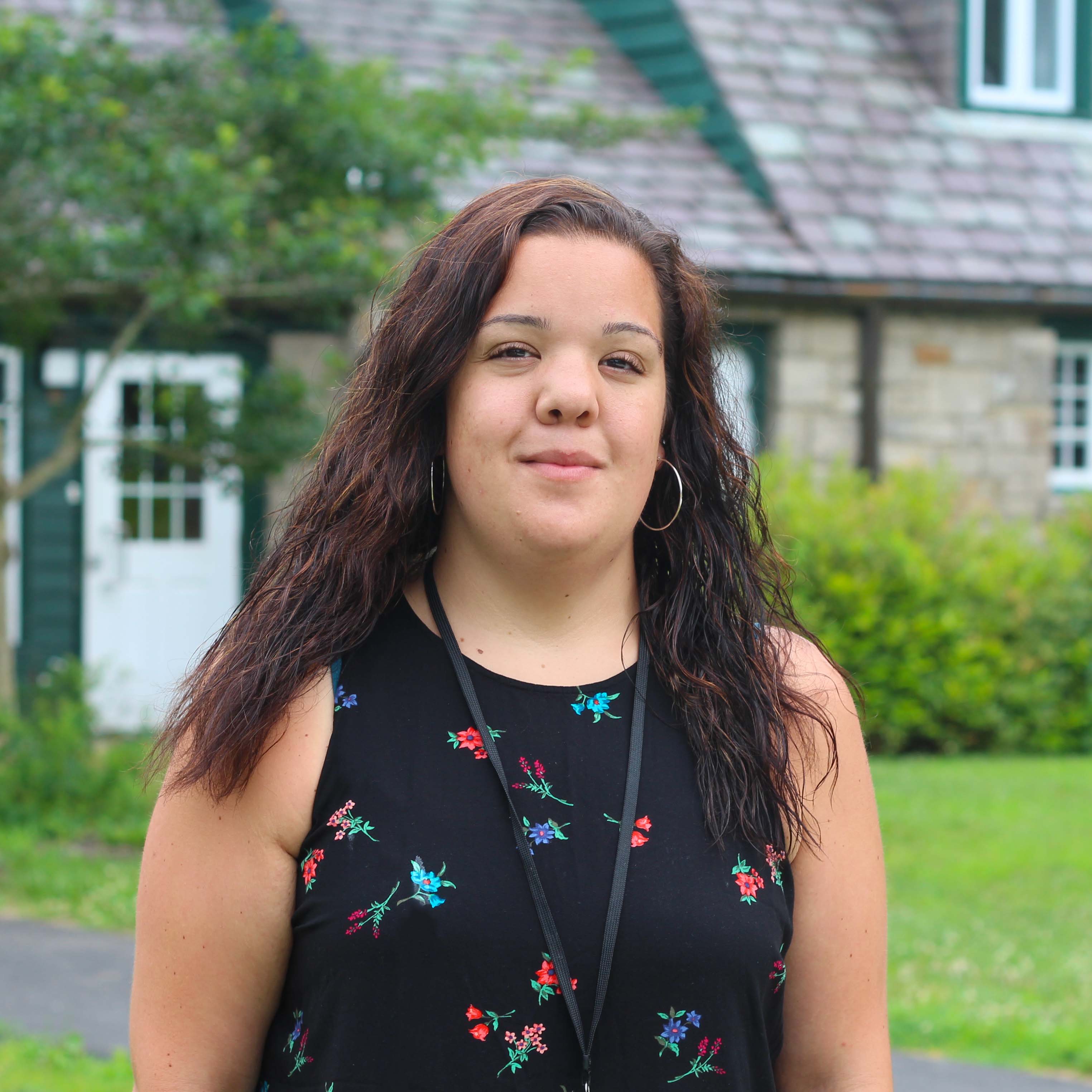Sharmaine Gregor ’19
Environmental Studies
The rising sun, already searing, illuminates scattered trash left by visitors the night before. Gathering the garbage, Mitchell College student researcher (now alum), Sharmaine Gregor next stoops to collect weeds and perform a visual scan of the flat areas for signs of plant growth. This regular routine offers Gregor insight into the unique marsh characteristics such as leaded areas, high salt levels, and flood plain sections at Dodge Paddock and Beal Reserve in Stonington Borough.
When she first enrolled in classes at Mitchell, Sharmaine wasn’t planning to become a full-time student, do research, or complete her degree here – she simply wanted to learn about the science behind sustainable food growth to help her teach others from a place of deeper understanding. The environmental studies major and East Lyme local poses a question…
“How do we foster curiosity without destroying the environment?”
Sharmaine’s interest in learning about the environment continued to grow as she spent time taking classes at Mitchell, until finally she was taking on a full course load. In particular, a science and public policy course with Dr. Christine Ramsay encouraged her to dig into the history of each environmental case study and connect them to modern day issues. Dr. Ramsay has not only helped Sharmaine develop her research and communication skills — she has also been a trusted advisor.
“We talk about real things,” said Gregor.
Though she has been busy with classes, she still finds time to pursue her passions, participating in the student-run Environmental Science Club, tending to plots in the Mitchell College Community Garden, and volunteering with F.R.E.S.H. (Food, Resources, Education, Security, and Health) New London.
In June 2018, Sharmaine was given the opportunity to take on one of the first paid Research Assistantships in Mitchell College history through a grant from the Southeastern New England Educational and Charitable (SNEC) Foundation, under Dr. Ramsay’s supervision.
She took this next challenge in stride, and set a personal goal to learn as much as she could about marsh restoration, including primary and secondary succession, and human impact. Her research is important for the area’s vitality, as sand marshes provide natural buffers, similar to sand dunes, which protect coastal developments from sea level rise and storms.
Gregor plans to pursue a master’s degree studying ecology and continue her research on the anthropogenic, or human-caused, impact on the environment.
The Science Behind the Story
Dr. C.N. Ramsay, Mitchell College Sciences Professor
ramsay_c@mitchell.edu
Climate related ecological changes are affecting all parts of the world, increasing susceptibility to those areas already altered by human activities. Marine coastal regions are particularly susceptible, as humans have impacted coastal regions for a long time, through activities such as resource acquisition (fishing, etc.) and coastal development. Rising temperatures, increasing sea level, changes in nutrient availability, along with stronger and more frequent storms are all predicted to exacerbate these already fragile habitats. The associated ecological changes will likely alter the dynamics of plant and animal populations, shift the distribution of species and potentially cause local and widespread species extinctions. These ecological changes will likely lead to a loss of ecosystem services that are provided by these coastal habitats.
As salt marshes play an important role in the transition areas between land, brackish and marine habitats, the need to understand and preserve these habitats from the effects of rising sea level and increasing storm frequencies is vital. With sea level predicted to rise even further, and storm intensities and occurrences also predicted to rise (IPCC, 2013 & NOAA, 2018), a number of threats are associated with coastal habitats, such as erosion and invasive species.
As erosion and the presence of invasive species increases, these marshes will no longer perform their natural functions such as exporting energy rich materials that are important to food webs in nearby marine habitats and deeper waters or provide a nursery to many commercially important fisheries and shellfish stocks. Migratory and resident bird populations also rely on wetlands and marshes to provide critical feeding and breeding habitats. Salt marshes also intercept land-derived nutrients. These nutrients can be absorbed and sequestered by the physical and chemical processes naturally found in wetland habitats, preventing them from entering oceans and altering many larger ecosystems. Furthermore, marshes provide stabilization to our shorelines, preventing further upland erosion and allowing for commercial development.
Coastal Erosion:
Coastal erosion is threatening our shorelines more than ever with increases in sea level heights, more frequent and intense storms, along with increased runoff from land. In order to prevent further erosion and begin to rebuild marshland, culverts can be dug to drain excess water from upland habitats within the marsh. Proper tidal flow from culverts can also prevent the buildup of stagnant water, thereby decreasing mosquito breeding habitats and facilitate the growth of native species. One alternative, and natural, solution is the dominant plant found within the marshes, the native cordgrass, Spartina alternifloria, which can be used to increase sedimentation rates. Outgrowth of their underground roots and rhizomes can also be used to retain additional sediment in the marsh that is typically removed during tidal cycles and storms. However, it is this native cordgrass that is also threatened by non-native species, such as Phragmites australis (the Common Reed).
Invasive Species:
Invasive species are species that are not native to an area and cause economic or ecological harm. In local salt marshes, the common reed, Phragmities australis subsp. australis, has been outcompeting native plants and dominating many of these habitats. Due to its wide range of temperature and salinity tolerances, the common reed has the ability to crowd out native species of plants, and thus alter the distribution and abundance of other species reliant on the native cordgrass, as well as degrade local habitats. Various methods can be used to control the spread of the Common Reed, including selective herbicide spraying and restoring natural tidal flow to levels that support the growth of the native S. alterniflora cordgrass and any re-plantings of S. alterniflora. The installation of culverts can also facilitate S. alterniflora growth as seeds from nearby local marshes are washed in with the tides, and allows for the proper flushing of plants.
You might also like…
Discovery on the Docks.
Zachary Marmo ’17
Academics: Environmental Studies with minor in Psychology, graduated Summa Cum Laude
When science gets hands-on, it isn’t just white coats in a laboratory. It can be pulling “settlement plates” off a dock in cold water with banged up knuckles on numb hands. That’s what an environmental studies major would expect when he dives into marine biology. What he didn’t expect as an undergraduate was…
Dressed for Success.
Madison Benton-Neylon, ’19
Academics: Liberal & Professional Studies
When Madison arrived for the first day of her internship at Galina’s at Mohegan Sun, she wasn’t quite sure what to expect – or what she could bring to the table as an intern — at this high-end boutique located in a world class casino. Just days into the internship, Madison found her mojo.
In Pursuit of a Passion.
Jessica Servidio ’18
Academics: Early Childhood Education, graduated Magna Cum Laude
After transferring to Mitchell College, Jessica Servidio quickly felt at home, forming relationships with the education faculty, shadowing teachers at the Children’s Learning Center (CLC), and making friends with other education students as they took the preschool children around campus to explore Mitchell’s unique surroundings. The valuable experience she gained in this personalized learning environment helped launch…





